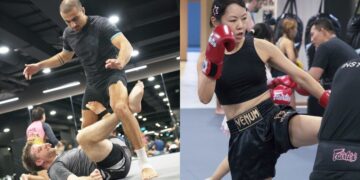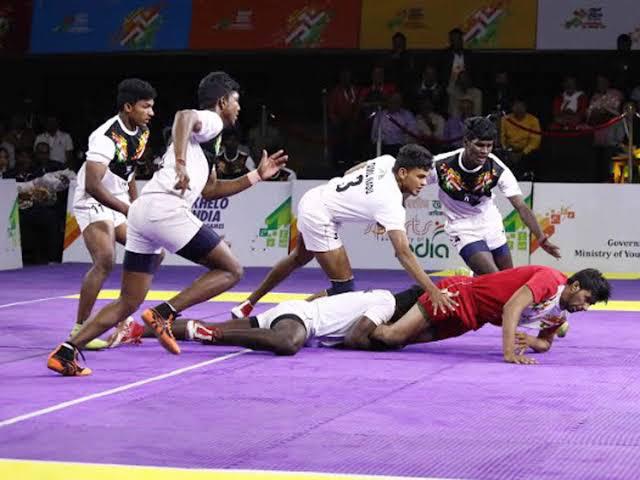
BJJ is known for its complex ground game, but every match begins on the feet. Whether you’re competing in the Gi or No-Gi, your ability to control and pass the guard sets the tone for the rest of the match. While many athletes rely on speed-based or distance-style passing, pressure passing remains one of the most consistent and effective ways to break through the toughest of guards. Within that category, the body lock pass has emerged as one of the most powerful tools for both high-level competitors and everyday practitioners. Today, we’ll review the basics of the body lock pass in Jiu-Jitsu.
Attacking The Guard In BJJ
Passing the guard is one of the most technical and challenging aspects of Brazilian Jiu-Jitsu. Guard players have access to a wide range of attacks, sweeps, and grips that make passing a constant battle for posture, balance, and control. A good guard pass is not just about strength or athleticism; it also requires a solid understanding of body mechanics.
You must first break through your opponent’s frames and grips, then stay tight enough to avoid counters while finding the path to advance. If done well, passing the guard not only earns points but sets you up to dominate the remainder of the match.
Why Pressure Passing Works
Pressure passing involves staying close, applying constant weight, and giving your opponent as little space as possible. Unlike speed passing, which often uses movement to avoid the guard, pressure passing breaks the guard by crushing it. The idea is to smother your opponent’s hips, eliminate their ability to frame or recover guard, and advance step by step.
This approach has several benefits. It reduces the chances of getting caught in scrambles or counters. It wears your opponent down mentally and physically. And most importantly, it often leads directly into control positions like side control or mount without giving up space.
The Body Lock Pass
The body lock pass is a form of pressure passing that focuses on wrapping your arms around your opponent’s midsection, locking your hands, and using your chest and hips to pin them to the mat. The grip removes your opponent’s ability to move their hips freely and nullifies many forms of guard retention.
Once the grip is locked, the guard passer begins to flatten their opponent and work their way around the legs, using small adjustments in angle and pressure to break down resistance. Because it involves minimal space and tight contact, the body lock is especially hard to counter, making it a reliable option at every level of grappling.
Types Of Body Lock Pass
As the body lock pass has grown in popularity, different styles and adaptations have developed. While the underlying concept remains the same (locking the body and applying pressure), each variation offers different angles and control points. Below are three of the most widely used and proven body lock pass styles.
1) Standard Body Lock
The standard version is performed from a crouched position after breaking the opponent’s guard. The passer drops their weight and locks their hands around the opponent’s waist or lower back. Keeping the elbows tight and the head low, the passer flattens the hips and begins working to one side, clearing the legs and establishing control. This is a slow, grinding pass that relies on precision and patience rather than explosiveness. It’s especially effective against active guards that rely on hip movement, since the grip neutralizes those motions entirely.
2) High Body Lock
In this variation, the grip is set higher on the torso, typically around the mid-back or just under the ribs. The high body lock works well when the guard player is already flat or has a weak frame. This version provides better upper body control, which can prevent your opponent from sitting up or creating space with their arms. With good head positioning and steady pressure, the passer can gradually slide past the legs and establish dominance without ever losing contact.
3) High Tripod Pass
A favored approach of standout grappler Jozef Chen, the high tripod pass uses a standing or semi-standing posture combined with an underhook and head post. Instead of crouching low, the passer posts on their feet in a wide tripod and maintains a good and stable base throughout. This allows the passer to move side to side and switch angles while keeping consistent pressure on the opponent’s hips. The elevation also reduces the risk of getting swept, as the weight distribution is easier to manage. This style is ideal for No-Gi and has been proven effective at the highest levels of competition.
Systematizing The Body Lock Pass
To use the body lock pass effectively, it helps to treat it as a system rather than just a technique. Start by developing reliable entries. These may come from breaking the closed guard, forcing half guard, or engaging from standing. Once the lock is secured, you must focus on posture, balance, and control.
The key is to keep your hips connected, stay low, and never allow your opponent to create space. Drill the transitions between stages, locking the grip, flattening the hips, and clearing the legs. Consistent repetition builds timing and will make your moves automatic.
Other Considerations
While the body lock pass is effective, it does have its limitations. Some opponents will frame hard against your face or shoulders, making it difficult to close the space. Others may use inversion or flexible hip movement to create problems during the pass.
In these situations, it’s important to remain patient and adjust your positioning rather than forcing the movement. Additionally, practitioners with shorter arms or limited mobility may need to modify grips or angles to make the body lock feel natural.
It’s also worth noting that the body lock can be tiring. Holding a strong squeeze while maintaining posture takes physical effort, especially over long rounds. Developing grip endurance and core strength will support your ability to maintain the position throughout a match.
Conclusion
The body lock pass has become one of the most reliable and effective guard passing tools in modern BJJ. By learning different variations of this amazing technique, you can adjust your approach based on the opponent’s reactions. Add this approach to your game, and you’ll improve your passing success, guaranteed.
You may also like:
What Can We Expect From Diogo “Baby Shark” Reis’ ONE Championship Run?
How To Turn The Tables From Bottom Side Control In BJJ
Recently, many Brazilian Jiu-Jitsu grappling stars have made the move to showcase their talent on the ONE Championship global stage. One of the most exciting new acquisitions is Diogo Reis, joining the ranks of Marcelo…
Getting stuck in side control is something many Brazilian Jiu-Jitsu beginners have in common. The bridge and roll is often the first reversal BJJ students learn, followed by basic bottom guard sweeps like the scissor…
In the ever-evolving world of BJJ, there has been a noticeable shift in how practitioners approach the ground game. Many practitioners now emphasize their leg lock game, which is now considered a must-learn across all…
Fear is a natural part of competition, especially in combat sports like Brazilian Jiu-Jitsu (BJJ), Muay Thai, boxing, and mixed martial arts (MMA). Whether you’re a first-time white belt entering your local tournament or a…
Brazilian Jiu-Jitsu is a martial art that offers many ways to finish a match. A common yet practical way to do this is to attack the opponent’s arm with a variety of arm locks. In…
Every year, athletes embark on their Brazilian Jiu-Jitsu journey filled with hope to make their dreams come true and make history. With a month coming before the World IBJJF Jiu-Jitsu Championship 2025, grappling fans can’t…
Generally speaking, every major martial art starts with standing up. Whether you’re a striking-based martial artist competing in Muay Thai or Boxing, or a grappler training in BJJ or wrestling, learning how to engage in…
Have you ever watched the fight winner declared and thought, “Wait… how did they win that?” Welcome to the sneaky, strategic, and often misunderstood world of stealing rounds. It’s not cheating. It’s not luck. It’s…
You’ve probably seen Floyd Mayweather slip punches in a boxing match like he’s Neo in the Matrix as he hands out boxing clinics. The Philly shell is the foundation of Mayweather’s airtight defense, rarely leaving…
In any striking-based martial arts such as Muay Thai, switch-hitting is a difficult skill but a tremendously valuable one to learn. Seamlessly changing your stance midway through a round completely changes the dynamic of a…
Bullying remains a serious problem worldwide. Over 30% of students globally have been victims of bullying, according to a UNESCO report. The consequences of bullying aren’t trivial either, with victims often feeling humiliated and helpless….
In Muay Thai, kicks are some of the most powerful and effective weapons. A well-timed roundhouse can break rhythm, score points, or end a fight. But kicks also come with risk. When you throw a…



































